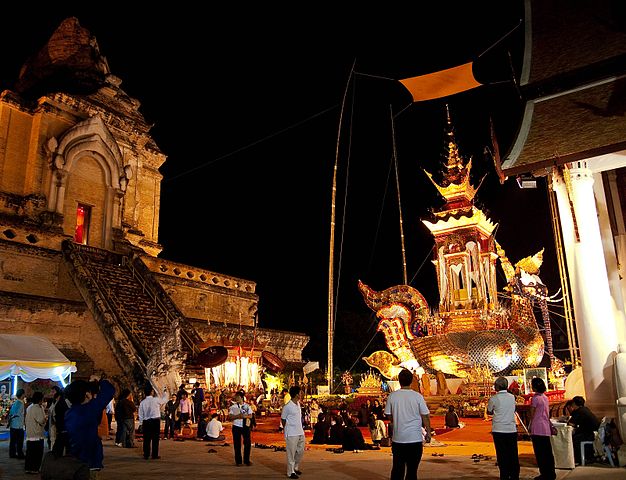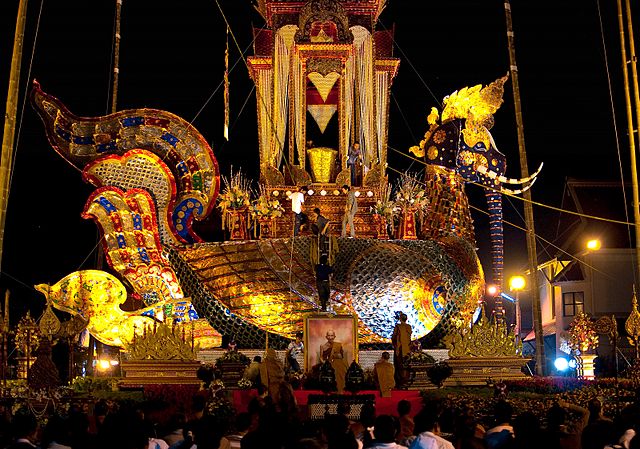
The ongoing innovative digital scanning project of the Thammasat University – Wat Bowonniwet Vihara Cremation Collection has made over 1000 volumes available online.
This ever-growing collection of digitized cremation volumes available on archive.org is the result of a cooperative initiative between the Thammasat University Libraries and Wat Bowonniwet Vihara, the major Buddhist temple in Phra Nakhon district, Bangkok. Wat Bowonniwet Vihara is a center of the Thammayut Nikaya school of Thai Theravada Buddhism and a major temple of patronage for the Chakri dynasty. Among the princes who have studied and served as monks there is His Majesty King Bhumibol Adulyadej. His Majesty’s great-grandfather, Rama IV, HM King Mongkut, arrived at the temple as a prince in 1836 and later became its first abbot.
As the historian Ronald D. Renard noted in 2000 in The Journal of the Siam Society, books printed to be distributed at Thai funerals
provide much culturally important information… the use of this as a means for disseminating important literature was popularized by Prince Damrong Rajanubhap after he became the head of the Vajirafiana (National) Library in 1915. The overall growth of the Thai economy since the early 1980s has resulted in more cremation volumes being prepared with a consequent increase of significant literature found in them …The six-volume set of books prepared for the funeral of Dr. Sanga Sabhasri [Founder of the Botanical Garden Organization] contains valuable information on forestry, botanical research, and related matters…Besides material on the deceased, cremation volumes often included chronicles, religious treatises and royal addresses.
An article by Professor Grant A. Olson of Northern Illinois University, Thai Cremation Volumes: A Brief History of a Unique Genre, was published in Asian Folklore Studies in 1992. Professor Olson observes:
Scholars who have studied Thai culture have often depended on a literature unique to Thailand – cremation volumes … These booklets, published and distributed as gifts on the occasion of cremation ceremonies, have been a rich source of literature, folklore, history, and biographical information.

In 1965, John M. Echols, professor of linguistics and literature in Cornell University’s Southeast Asia Program, coauthored an article for The Library Quarterly which quotes one of his graduate students:
The largest proportion of materials published in Thailand, however, consists of what are known as cremation volumes, published for distribution to guests at cremation ceremonies as a memento of the deceased… These books are very often of first-rate importance, often containing collections of historical documents, or important biographies, or works of literary or religious interest. Depending on the budget of the hosts, the cremation volumes will be printed in editions of a few hundred to several thousand copies, and range in size from twenty to two thousand pages.
In addition to a strong collection at the National Library of Thailand, Cornell University’s Echols Collection today houses a group of these books. In 1989, the Center for Southeast Asian Studies, Kyoto University, Japan, published a catalog of some 4,000 cremation volumes acquired from Khun Charas Pikul. According to Kyoto University, this is the largest collection of such volumes outside Thailand.
Northern Illinois University, USA — site of the founding in 1972 of the Council on Thai Studies (COTS), an informal organization of scholars – is another noteworthy library collection of cremation volumes, as is the National Library of Australia. As the librarian Rosemary Borthwick explained in National Library of Australia News in 1996,
Cremation volumes… are published in strictly limited soft-cover editions by relatives, friends and colleagues of a deceased person, and range from a single slim volume for a member of the general public to a voluminous production in the case of royalty, the nobility and persons of importance. Each volume may be the contribution of a different organisation or group of persons, and such publications are frequently an invaluable repository of information not provided elsewhere, and are much sought after as a consequence.

The National Library of Australia (NLA) collection of cremation volumes contains around 3000 titles in over 4000 volumes, acquired since the 1960s. The earliest volume in the collection was published in 1910, printed “on the occasion of the cremation of His Majesty King Chulalonkorn.” The NLA website notes:
We actively acquire cremation volumes quickly after they are produced; they are not sold commercially but acquired through dedicated dealers who are assisting us to build this cultural resource. You can search for Cremation Volumes online in the NLA catalogue using the name of the deceased. Recently acquired volumes (from 2007) are catalogued in Thai for easy searching, otherwise you will need to search using romanized spelling.
Wat Bowonniwet Vihara also became a center for these treasured and much-sought-after books in the 1970s, when the journalist Nares Naropakorn invited readers to donate cremation volumes to found a special collection. Professor Olson’s article quotes a bulletin of the Wat Bowonniwet Vihara Library from 1972, stating that Khun Nares argued that
all of these books that were just handed out were worth reading and deserved to be studied. Some of the essays and articles contained in them were very rare. Some had never seen general publication before. Some of the stories were very strange, and, furthermore, what is especially interesting are the biographies of the deceased that they contain. So, if people were to put together a cremation-volume library somewhere, this could be of tremendous value to those who wanted to study these volumes.

Wat Bowonniwet, which already had a library founded in 1954, was settled upon, and many thousands of donations ensued. Among those volunteering time to organize and catalogue the collection were Khun Tongyot Pratoomvongs of the Thammasat University Libraries, among many other colleagues, faculty, and students who continue as volunteers today. As the collection developed, its aim became to preserve a copy of each cremation volume printed in the Kingdom. One of the obvious advantages to digitizing these important historical sources, apart from preservation, is making them widely accessible to readers worldwide, as opposed to the relatively limited hours for consulting original materials at Wat Bowonniwet.
How cremation books originated in Thailand.
Professor Olson notes that Dan Beach Bradley (1804 –1873), an American Protestant missionary to Siam from 1835 until his death, is credited with bringing the first Thai-script printing press to Siam. There he printed government documents, as well as Christian religious texts. Rama IV, HM King Mongkut, who was still a monk at Wat Bowonniwet at the time, observed this new technology with his usual forward-looking and inspired attitude, and ordered a printing press for Wat Bowonniwet so that monks might print their own literature. Distributing books for free was part of Thai tradition of gift giving and merit making, and as Khun Tongyot told Professor Olson, books last longer than many other gifts. Experts disagree on whether the first printed cremation volume appeared in 1880 or 1901. Some scholars even argue that cremation volumes were also created before 1880. Whatever the truth, Professor Olson sums up:
Thai cremation volumes can usually be identified by their white, black, or silver-gray covers, although the combination of fuchsia and black is currently enjoying some popularity. The earliest volumes did not always contain a biography of the deceased; this practice began around 1895. Almost all recent samples of cremation volumes are composed of a short biography of the deceased, eulogies from friends and relatives (called kham wai-dai), and selected essays or pieces of prose and literature. Often the “look” of these volumes, their length, size, and quality of appearance can be an indicator of status. Some publications have gold-gilted covers and contain numerous color photographs, while others are simply folded, scaled-down paper replicas of palm-leaf manuscripts with a few (Buddhist) aphorisms printed on each panel and a cover bearing the name of the deceased and perhaps the date of birth and death. Some are very careful productions, while others are poorly edited and proofread, and are of relatively inferior design and binding. The final quality of the cremation volume depends largely on the education and means of the family producing the book and the time and care taken to put it together. The volumes often contain works that had been personal favorites of the deceased or the family. By republishing long-out-of-print material many were intended as a contribution to the preservation of Thai literature.
While these books started as highly serious collections of Buddhist texts, reportedly in 1904 HM King Chulalongkorn, Rama V, suggested that the books could be more fun for people to read, including fables, tales of previous births of the Buddha, and fiction. Later funeral books would contain information on biography, train travel, royal court language, cooking, and traditional medicine. The content, while fascinating for historians, sociologists, and other scholars, might not always make obvious sense. Professor Olson points to one volume commemorating a man who had died of a heart attack, containing articles on cancer, the dangers of electricity, and instructions on how to grow sour tamarind. Naturally, how these texts are used is up to readers. David Thompson, an Australian chef who specializes in Thai cuisine, has a collection of over 500 Thai funeral books, each featuring a recipe, which he used to prepare dishes served in his restaurants, including Nahm Bangkok at Metropolitan South Sathorn.
Professor Eiji Murashima of the Graduate School of Asia-Pacific Studies, Waseda University, Japan, wrote an article in Modern Asian Studies in 2006, advising historians to use cremation volumes and related publications with caution as literal sources of historical information. Professor Murashima underlines that these were not always intended as objective histories. Critical readers may still be inspired and enlightened by these cremation volumes, now readily available in the digital scanning project of the Thammasat University Libraries and Wat Bowonniwet Vihara.

(All images courtesy of Wikimedia Commons).
